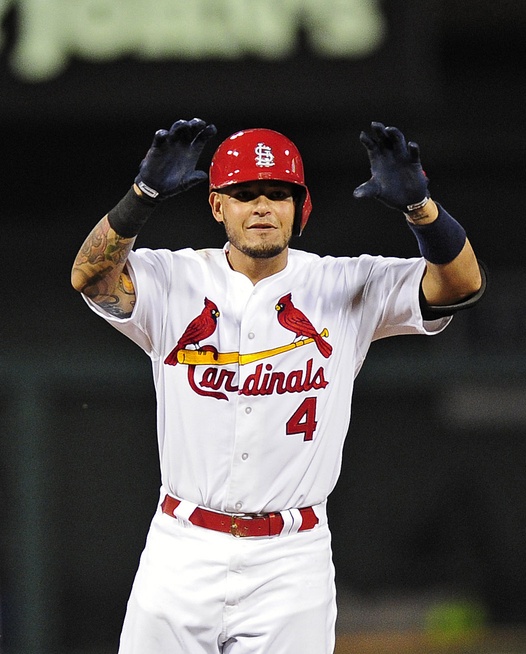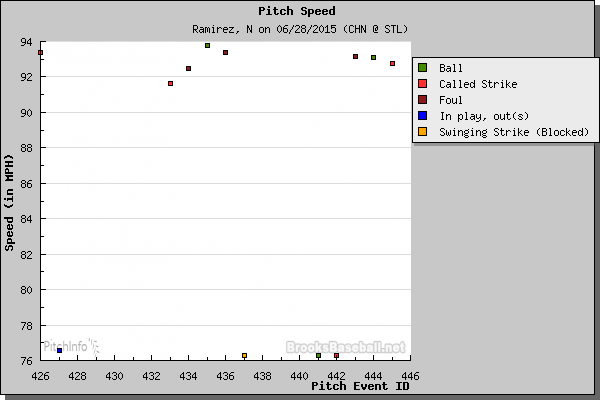Top Play (WPA): Coming into the bottom of the fourth inning, the game was tied at one and Jason Hammel was getting by with erratic stuff. He hadn’t looked quite the same since returning from a lengthy rain delay (one hour and 49 minutes, to be precise) just before the bottom of the second inning. This inning, however, his erratic control got the best of him.
Jhonny Peralta led off the inning with a line-drive double, and Jason Heyward followed with a double to score Peralta and break the tie at 2-1 (.120). Hammel struck out Randal Grichuk, but Yadier Molina doubled to right field to break the score open at 3-1.
Hammel would get out of the inning and come back out for the fifth, but Kolten Wong’s leadoff double would knock Hammel from the game in favor of James Russell. Wong would come around to score on (you guessed it) a double by Matt Carpenter, bringing the score to 4-1, which would also end up being the final tally on the evening.
I hate to complain about natural events ruining things for the Cubs, but Hammel threw eight of his 11 pitches for strikes in the first inning and was hitting his spots with regularity. Once he came back out after a nearly two-hour delay, he was struggling to hit his spots and the Cardinals eventually took advantage. Carlos Martinez had to pitch under the same conditions, however, and also looked a bit erratic at first. But the Cubs simply couldn’t figure out how to get to Martinez, and he settled in and appeared to get stronger as the game went on, regularly pumping his heat in the upper 90s.
Bottom Play (WPA): When Martinez did come out to pitch in the top of the third inning, Dexter Fowler ran the count full before hitting a double to right field. Martinez then unleashed a wild pitch during the at-bat with Kris Bryant, who had a perfect opportunity to drive in a run with just a fly ball or a ground ball. But Bryant struck out swinging (-.055) on a ball in the dirt, which is strikeout number 13 for Bryant since his 12-game hitting streak came to an end, a span of 10 games. During that time, Bryant is hitting .147/.250/.353.
Anthony Rizzo did pick up the slack for Bryant, driving a line out to left field that allowed Fowler to tag and come home. That tied the game at one, but it was the only run the Cubs would score all night. They’ve now scored seven runs in their last six games, going 1-5 over that span.
Key Moment: The big thing to take away from this game is that Neil Ramirez returned from the disabled list. He came on to pitch in the seventh inning and faced Jon Jay, Greg Garcia, and Wong. He got a line out to left from Jay on two pitches, and then struck out Garcia and Wong. He threw eleven pitches in total, and although his fastball didn’t hit his usual 95-97, he still looked sharp. Here is a plot for the velocity on his pitches, with seven of them being fastballs and the four at the bottom representing the curveballs that he threw.
Having Ramirez back represents the beginning of what is hopefully a slew of returns from players who are currently on the disabled list. All of the talk during the national broadcast of last night’s game was about how the Cardinals keep winning in spite of injuries, but it’s been overlooked that the Cubs have stayed in the Wild Card race despite the inconsistency of Jon Lester and the injuries to Ramirez, Jorge Soler, Javier Baez, Mike Olt, Tommy La Stella, Tsuyoshi Wada, Zac Rosscup, and Jacob Turner.
Trend to Watch: It’s no secret that Starlin Castro has struggled at the plate this season. But there are a few interesting things to note about his slash line.
|
Year |
Batting Avg |
OBP |
SLG% |
BABIP |
K% |
|
2014 |
.292 |
.339 |
.438 |
.337 |
17.3 |
|
2015 |
.260 |
.292 |
.338 |
.296 |
16.0 |
The drop in BABIP is .041, and yet he’s placing a higher percentage of pitches in play because of his lower strikeout rate. Just a cursory look at this might suggest that he’s had some bad luck, and that could be a small part of it. But the greater problem is the types of balls in play that Castro has had this year. Castro continues to struggle with quality contact; here are his career numbers on balls in play.
The big thing that jumps out is that Castro’s line drive percentage for his career is 20 percent, but he’s down to just 15.5 percent this season. His ground ball percentage is way up, from 45.3 in 2014 to 56.3 this season. This matters because, historically, players have a very high batting average on line drives but very low average on ground balls. It also doesn’t help matters that 17.1 percent of the fly balls Castro has hit are of the infield pop-up variety, compared to his career rate of 8.1 percent.
You’ll also notice at the very end it lists whether the contact is hit “soft,” “medium,” or “hard.” Castro’s making way more soft contact than he normally does, while making way less hard contact. If he is going to get back to the guy from 2014 again he’s, going to need to make adjustments. Whether it be adjusting to the types of pitches he swings at or adjusting his swing to be more conducive to line drives and fly balls, he needs to figure out what he needs to do differently at the plate. Otherwise, these problems are likely to continue.
Coming Up Next: The Cubs (39-35) have a merciful day off today while they head to New York to start a three-game series with the Mets (40-37) tomorrow. Kyle Hendricks (4.46 ERA/3.75 FIP/5.02 DRA) matches up against Jon Niese (4.12 ERA/4.43 FIP/6.28 DRA), who popped up in trade rumors involving the Cubs over the weekend. After their series with the Mets, the Cubs have a stretch of 23 of the next 27 against under .500 teams. During that time, it’s expected that they should get Soler and Olt back. If the Cubs are going to make a serious run at a Wild Card spot, this will be a very important stretch of the season.
Lead photo courtesy of Jeff Curry-USA TODAY Sports



Is anyone else getting tired of Joe Maddon’s “I love the quality of effort” and “we’re young and we’re going to improve” act?
What is this? Gymnastics and figure skating? Style points don’t count, performance does, scoring runs and preventing runs, neither of which the Cubs are good at right now.
And the “we’re young” crap doesn’t hold water either. The Astro are young, they strike out as much but hit many more HRs. The Dodgers have young players who are performing better. Ditto Tampa Bay, San Francisco, Boston.
Plus, Bryant and Russell didn’t go 2 for 27 with RISP last weekend by themselves. This team has plenty of experienced veterans, Fowler, Montero, Castro, Lester, who are not playing well. You can’t pin it all on the youngsters.
The Cardinals lose Wainwright, Holliday, Adams and Taveras, and their mostly unheralded call-ups play like all-stars.
Here’s a scary thought, what if what we see of Bryant, Soler and Russell is as good as they ever will be, i.e. good or average but not great? Sure, some players have had bad rookie seasons (Harper, Rizzo) and go on to improve and become elite. But plenty of players have had their best season as rookies and decline from there (see http://www.fangraphs.com/blogs/hitters-no-longer-peak-only-decline/). There are better young 3B than Bryant right now (Arenado, Machado, Duffy) and better SS/2B than Russell (Correa, Panik, Bogaerts). Bryant, Soler and Russell have way too much swing and miss and really ugly looking ones at that which is only ok if you’re David Kingman hitting 50 HRs.
And the FO’s emphasis on hitting over pitching is starting to show its flaws as Boston is also finding out. You need a balance as quality pitching will usually beat quality hitting (as the Cardinals and Mets have shown, the Cards have an average offense but its pitching has gotten them the best record).
1. The arms that have been drafted are 3-5 years off, meaning they will be ready when the hitters are past their peak or leave in FA.
2. The FO thinks that picking up other teams’ rejects via waiver wire will do the job (Dubront, Bard, Britton, Roach, etc…. it’s a long list). Roach???? How’s that working out for you? Reminds of the Casey Coleman era when he was the TOP pitching prospect. The Cardinals bring up aces left and right out of their farm system.
3. I seriously question the FO’s pitching talent evaluation. Look at the contracts given out to FAs. Edwin Jackson, Jon Lester, Jose Veras, Phil Coke, Fujikawa. The only one that has worked out so far is Hammel and it is only for 2 years. Another big FA $20-25M/yr dud is going to push that roster payroll efficiency right off the cliff. Imagine 3 mediocre pitchers taking up 40% of the budget next year.
And what’s up with the Cubs and great pitchers? Either they have some great seasons but more years with other clubs (Fergie Jenkins who was obtained via trade), have most of their peak years elsewhere (Greg Maddux) or are jinxed (Kerry Wood and Mark Prior who had 2003 and Dusty Baker happen to them). Even the White Sox stumble on good pitchers more often in the draft. Wrigley Field probably ranks second only to Coors for where pitchers go to die.
This team has been skating on the edge the whole season (as evidenced by the 1-run and extra inning games). It won’t take much (an injury to Rizzo, Arrieta, Hammel) to push them below .500. They will be lucky to finish 3rd in the Central. They will not get a wildcard finishing behind Pittsburgh and San Francisco. What do the teams that lead their divisions have in common? Good pitching and they put the ball in play. Only the Astros and to some degree the Orioles are having success with the all or nothing approach to hitting. The Cubs are striking out and only average in HRs. They do not hit with RISP. Perhaps they should change #WeAreGood to #WeAreMeh.
I appreciate you taking the time comment. After the initial angst of the Cardinals series, followed by a sweep in New York, does your feeling on the team change much?